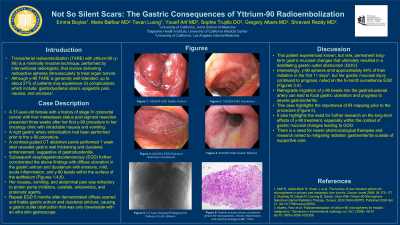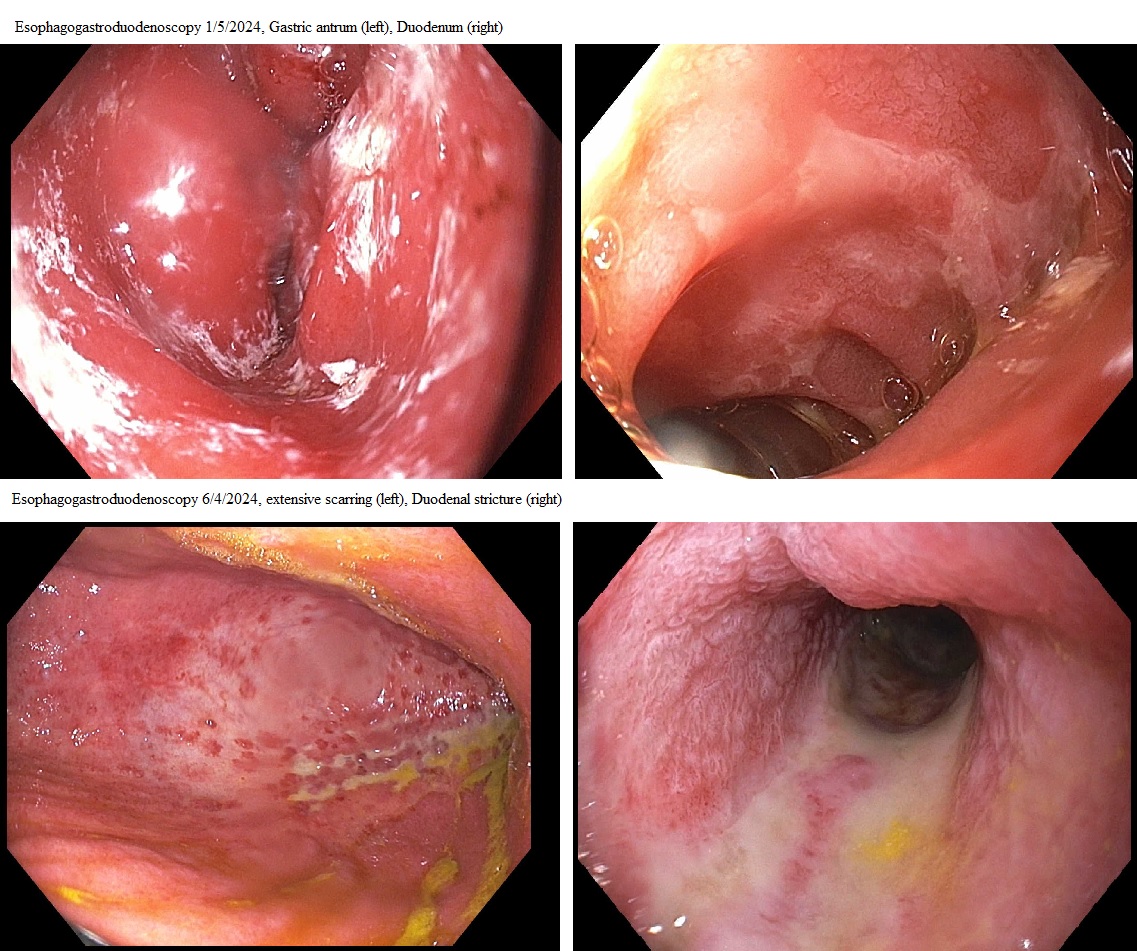Sunday Poster Session
Category: General Endoscopy
P0714 - Not So Silent Scars: The Gastric Consequences of Yttrium-90 Radioembolization
Sunday, October 27, 2024
3:30 PM - 7:00 PM ET
Location: Exhibit Hall E

Has Audio

Emma Boyles
University of California Irvine School of Medicine
Irvine, CA
Presenting Author(s)
Emma Boyles, 1, Yousif Arif, MD1, Tevan Luong, BS2, Sophie Trujillo, DO3, C Gregory Albers, MD2, Shravani Reddy, MD2
1University of California Irvine School of Medicine, Irvine, CA; 2University of California, Irvine, Orange, CA; 3University of California Irvine, Irvine, CA
Introduction: Transarterial radioembolization (TARE) with yttrium-90 (y-90) is a minimally invasive technique in which radioactive spheres are delivered directly to a target organ. It is a commonly utilized therapy in liver tumors. Although y-90 TARE is generally well-tolerated, up to 27% of patients may experience GI complications (Neff et al, 2008). Here we report a case of severe and chronic gastroenteritis after migration of y-90 spheres to the stomach and duodenum.
Case Description/Methods: A 37-year-old female with a history of colorectal cancer status post sigmoid resection with extensive liver metastases presented with intractable nausea and vomiting to the oncology clinic 3 weeks after her first y-90 procedure. Right gastric artery embolization had been performed prophylactically to reduce the possibility of GI complication, but a CT abdomen pelvis 1 week after initial presentation revealed gastric wall thickening and duodenal enhancement, suggestive of gastroduodenitis. A subsequent esophagogastroduodenoscopy (EGD) and biopsy confirmed diffuse ulceration in both the antrum and duodenum with erosions, mild acute inflammation, and y-90 beads within the surface epithelium (image 1). Despite supportive care with proton pump inhibitors, carafate, antiemetics, and prokinetic agents, the patient continues to experience chronic epigastric pain, nausea, and vomiting. Repeat EGD 5 months after initial presentation shows diffuse scarred and friable gastric antrum and duodenal stricture, causing gastric outlet obstruction (GOO) only traversable with a slim scope (image 2). Her course is further complicated by portal hypertension and ascites in the setting of liver mass excluding her from percutaneous feeding or surgical management of GOO.
Discussion: GI complications after y-90 TARE include radiation cholecystitis, acute pancreatitis, cholangitis, and gastrointestinal ulcers (Mushtaq et al, 2024). Retrograde migration of y-90 beads into the gastroduodenal artery can lead to focal gastric ulceration and progress to severe gastroenteritis as seen in our patient even though the spheres emit 94% of their radiation in 11 days (Murthy et al, 2008). Physicians should be aware of the possibility of extensive non-healing ulcers and gastroenteritis progressing to strictures of the duodenum and GOO. Medical therapy is limited to supportive care with antisecretory and antiemetic drugs. In refractory cases, structure dilation and gastrectomy are considered.

Disclosures:
Emma Boyles, 1, Yousif Arif, MD1, Tevan Luong, BS2, Sophie Trujillo, DO3, C Gregory Albers, MD2, Shravani Reddy, MD2. P0714 - Not So Silent Scars: The Gastric Consequences of Yttrium-90 Radioembolization, ACG 2024 Annual Scientific Meeting Abstracts. Philadelphia, PA: American College of Gastroenterology.
1University of California Irvine School of Medicine, Irvine, CA; 2University of California, Irvine, Orange, CA; 3University of California Irvine, Irvine, CA
Introduction: Transarterial radioembolization (TARE) with yttrium-90 (y-90) is a minimally invasive technique in which radioactive spheres are delivered directly to a target organ. It is a commonly utilized therapy in liver tumors. Although y-90 TARE is generally well-tolerated, up to 27% of patients may experience GI complications (Neff et al, 2008). Here we report a case of severe and chronic gastroenteritis after migration of y-90 spheres to the stomach and duodenum.
Case Description/Methods: A 37-year-old female with a history of colorectal cancer status post sigmoid resection with extensive liver metastases presented with intractable nausea and vomiting to the oncology clinic 3 weeks after her first y-90 procedure. Right gastric artery embolization had been performed prophylactically to reduce the possibility of GI complication, but a CT abdomen pelvis 1 week after initial presentation revealed gastric wall thickening and duodenal enhancement, suggestive of gastroduodenitis. A subsequent esophagogastroduodenoscopy (EGD) and biopsy confirmed diffuse ulceration in both the antrum and duodenum with erosions, mild acute inflammation, and y-90 beads within the surface epithelium (image 1). Despite supportive care with proton pump inhibitors, carafate, antiemetics, and prokinetic agents, the patient continues to experience chronic epigastric pain, nausea, and vomiting. Repeat EGD 5 months after initial presentation shows diffuse scarred and friable gastric antrum and duodenal stricture, causing gastric outlet obstruction (GOO) only traversable with a slim scope (image 2). Her course is further complicated by portal hypertension and ascites in the setting of liver mass excluding her from percutaneous feeding or surgical management of GOO.
Discussion: GI complications after y-90 TARE include radiation cholecystitis, acute pancreatitis, cholangitis, and gastrointestinal ulcers (Mushtaq et al, 2024). Retrograde migration of y-90 beads into the gastroduodenal artery can lead to focal gastric ulceration and progress to severe gastroenteritis as seen in our patient even though the spheres emit 94% of their radiation in 11 days (Murthy et al, 2008). Physicians should be aware of the possibility of extensive non-healing ulcers and gastroenteritis progressing to strictures of the duodenum and GOO. Medical therapy is limited to supportive care with antisecretory and antiemetic drugs. In refractory cases, structure dilation and gastrectomy are considered.

Figure: (Upper) Esophagogastroduodenoscopy (EGD) images from 1/5/2024 from gastric antrum (left) and duodenum (right)
(Lower) EGD images 6/4/2024 with extensive scarring (left) and duodenal stricture (right)
(Lower) EGD images 6/4/2024 with extensive scarring (left) and duodenal stricture (right)
Disclosures:
Emma Boyles indicated no relevant financial relationships.
Yousif Arif indicated no relevant financial relationships.
Tevan Luong indicated no relevant financial relationships.
Sophie Trujillo indicated no relevant financial relationships.
C Gregory Albers: Nestle Health – Speakers Bureau. Phathom Pharmaceuticals – Speakers Bureau. Salix Pharmaceuticals – Speakers Bureau.
Shravani Reddy indicated no relevant financial relationships.
Emma Boyles, 1, Yousif Arif, MD1, Tevan Luong, BS2, Sophie Trujillo, DO3, C Gregory Albers, MD2, Shravani Reddy, MD2. P0714 - Not So Silent Scars: The Gastric Consequences of Yttrium-90 Radioembolization, ACG 2024 Annual Scientific Meeting Abstracts. Philadelphia, PA: American College of Gastroenterology.
